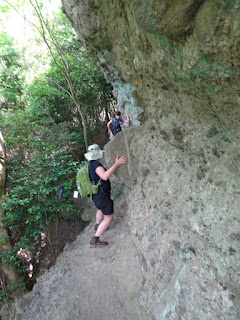
Our experiences the past six days of hiking in the remote areas of the Kunisaki Peninsula of NE Kyushu Island (the southern-most large island in Japan) were a stark contrast to our mostly city experiences our first 10 days in Japan. It’s peaceful, rural, steep, sacred, and serenely beautiful. The forests and mountains are every shade of green imaginable.
It is so nice to now have two local guides who can answer our questions and explain things we never thought to ask. And our group of 15 is downright fun!
 |
| We'll start working our way south from here |
We are hiking what are described as the “Ancient Buddhist Trails,” which date back to the origins of the Shinto religion over 2500 years ago and the Buddhist religion that followed 1300 years ago. They still coexist in peace and have intermingled to some extent. The trails were intended as a meditation and are marked with many Buddhist statues and Shinto shines, but not the kind you would expect in India or China.
 |
The Yanagigaura shrine, gateway
to the start of the Buddhist trails |
 |
Much of our trails were on volcanic
ridges |
 |
| Lantern near a shrine |
 |
| Cell phone Buddhas? |
Our trails are sometimes marked (usually in Japanese) and also hard to find, so it’s nice to have guides. We hike several hours a day through bamboo, cedar, cypress, rhododendron, and azalea forests, often up and down narrow rocky ridges. Fortunately we have chains and ropes in some parts. We came across small and large Buddhas everywhere, especially under rock outcroppings. It’s been hot and humid.
 |
A stone bridge with a huge
drop on each side |
 |
| Monks' gravestones near Kyu-Sento-Ji temple |
 |
Kathy hugging a rock on a ledge
(It's not as scary as it looks) |
 |
| Morning fog and a view of our trail on the left |
 |
The entrance to the Kyu-Sento-Ji temple,
one of many shrines and temples we passed through |
 |
| Himeshima Island |
On Thursday we left the mountains and spent he night on a small island, Himeshima. What made it unique was a special temple on a rock outcropping, and that it had children and young people on it. The rest of the countryside we’ve experienced appears deserted, with abandoned schools, rice paddies, and seldom used—but nice—roads. The average age is 75. Like in many parts of the US and the world, the young gravitate to the cities. Japans's restrictive immigration policies over the years has created this demographic time bomb and rural economic crisis.
 |
Our last bridge, crossing "The Void" and symbolizing
the end of the Buddhist pilgrimage trails |
 |
| Our roykan on Himeshima |
We spend each night in traditional Japanese inns, called ryokans. Each room provides bathrobes (called yukatas) and slippers which we can wear throughout the inn. The rooms are plain with straw mats. After dinner, the futons magically appear on the floor. The roykans all have hot soaking rooms, some of which are heated by natural springs. So civilized! You bathe before getting in.
 |
| Our room on Himeshima |
 |
| Our onsen in Yufin |
And did I mention food? Each night and most mornings, we have amazing Japanese feasts of all sorts of amazing tidbits, raw seafood, pickles, tempura, and more. And if we’re still hungry afterwards, the bring out bowls of rice.
Tonight we're in the spa resort town of Yufin, known for it's thermal hot spring baths. From this point forward we're exploring other hiking trails and volcanic features of Kyushu Island. It's been a wonderful and unique trip for us. And it's nice to be on an organized trip where we're hiking more, riding a bus much, much less.
Click here for more photos
 Our experiences the past six days of hiking in the remote areas of the Kunisaki Peninsula of NE Kyushu Island (the southern-most large island in Japan) were a stark contrast to our mostly city experiences our first 10 days in Japan. It’s peaceful, rural, steep, sacred, and serenely beautiful. The forests and mountains are every shade of green imaginable.
Our experiences the past six days of hiking in the remote areas of the Kunisaki Peninsula of NE Kyushu Island (the southern-most large island in Japan) were a stark contrast to our mostly city experiences our first 10 days in Japan. It’s peaceful, rural, steep, sacred, and serenely beautiful. The forests and mountains are every shade of green imaginable.
















Nice to see a part of Japan that most people miss.
ReplyDeleteWonderful photos! Thanks for taking us with you virtually on your amazing adventure!
ReplyDeleteLinda